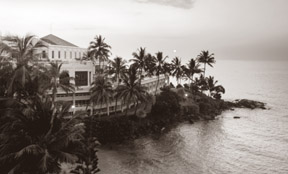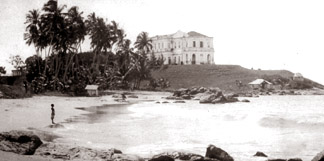

A tryst with colonialism


Mount Lavinia Hotel
celebrates its bicentenary with a touch of romance,
pomp and pageantry
The steam engine bearing the inscription ‘Sir Thomas Maitland’ pulled into Mount Lavinia Station. Descendants of Sir Thomas Maitland and Sir Robert Brownrigg, former Governors of Ceylon and special invitees disembarked from the royally furnished ‘Viceroy’ carriage to a red carpet welcome. Mount Lavinia Hotel was celebrating its Bicentenary.
 |
General Manager Bazeer Cassim received the distinguished guests while a concierge pulled the cart of metal trunks and crates, remarkably similar to those carried two centuries ago. Out stepped Dr. Doyle (played by actor Darrell Wallace) unexpectedly sent by Lord Camden of the Colonial Office. “I am here to investigate rumours of romantic trysts, a secret tunnel and a half naked dancing girl entertaining the Governor,” the gentleman dressed in period costume stated poker-faced, adding to the captivating portrayal of Mount Lavinia in 1805.
There was more: Potted plants lined the path leading to the gates of the palatial building, the former home of governors. A colourful entourage comprising drummers, dancers and white horses led the procession through the gates of the hotel where a host of exquisite dancers performed, bringing back memories of Lovina Aponsua and other damsels who had danced for Governor Maitland 200 years ago. The sound of trumpets brought to an end the spectacular welcoming ceremony.
This piece of the country’s colonial past was re-enacted at the Mount Lavinia Hotel on July 14 when portraits of British Governors of Sri Lanka between 1805 and 1831 - Lt. Gen. Edward Barnes (1819-1821 and 1824-1831), Gov. Edward Paget (1822-1823), Lady Sophia Brownrigg, Gen. Sir Robert Brownrigg (1812-1820) and Sir Thomas Maitland (1805-1811) were unveiled. The highlight of the event was the unveiling of a portrait of the mysterious Lovina Aponsua, said to be the low-caste dancing girl Sir Thomas fell in love with.
British High Commissioner, Dominick Chilcott said the ghosts of the past governments were probably watching the ceremony. “Although our roles and powers are different, both took instructions from the Secretary of State, both worked in accordance with the British government policy and acted in the interest of the British government,” he said of the commonalities in their roles.
For Henry Brownrigg, a descendant of Sir Robert Brownrigg, being at Mount Lavinia Hotel and viewing the bicentenary festivities took on a dreamlike quality. “Behind their uniforms, they were essentially human beings with human failings. While it is great to celebrate them, it would be wrong to glamorise them or demonise them,” he said.
Viscount Ian Maitland (19th Earl of Lauderdale) who was here for the occasion spoke of the events that led his forefather to initiate the landmark building. On a lighter note he continued, “Watching the dancers, I can understand why Sir Thomas who was not the marrying kind went into the forbidden romance.”
Mount Lavinia Hotel as part of its bicentenary celebrations launched a commemorative book ‘Mount Lavinia – the Governor’s Palace’ and opened its refurbished museum/gallery. Written by Shevanthie Goonasekera, the 136-page book published by London based Paradise Isle Publications run by two Sri Lankans provides information about the hotel’s history, architecture, occupants, festivities, etc.
|
Sir Robert Brownrigg
Descendant Henry Brownrigg explained that Sir Robert Brownrigg came from an Anglo Irish Army family and rose to service on his own abilities. “He was not rich by any circumstance nor did he have a wealthy relative to patronise him.” However, being a competent and meticulous soldier he attracted the attention of the Duke of York (brother of King George III) who was the Commander in Chief of the British Army. He was thus appointed as his Military Secretary, a position of influence and power. Sir Robert was then sent as the governor and commander-in-chief of the coastal provinces that were under British control, despite having had no experience in civil administration. It was fortunate that Sir Robert had as his chief interpreter John D’Oyly, a brilliant linguist and they made a good team. D’Oyly who had passed out of Cambridge with top academic honours was appointed as Chief Translator to the Colonial Office within three years of arriving on the island. He not only spoke excellent Sinhala but also knew of the proper etiquette and protocol when dealing with the Kandyan kings. “Some interpreters said that D’Oyly was the good cop and Sir Robert the bad cop. There is some truth in that,” Mr. Brownrigg admits. An art dealer in London, Henry Brownrigg is a frequent visitor to the Indian subcontinent. Sir Thomas Maitland
The Maitland Clan were from a province called Lauderdale near Edinburgh of southern Scotland where they had been since 1250. Their first ancestor could be traced to 1130 having come from Cotentin near Cherbourg in France and had been given land in Scotland. Dressed in the traditional Scottish kilt, Sir Ian spoke of Sir Thomas’s illustrious career. Sir Thomas first served as the Director of the East India Company and then was made a Major General. “His talents lay in administration,” Sir Ian says. On arrival in Ceylon, Sir Thomas, as British governor took a quick tour of the island and within three months submitted a 160-page report on its condition. Declaring that the previous governor’s house was in ruins, he insisted that he needed a new one. “He never expected a response nor did he receive one,” Sir Ian smiled. Six months later he sent another letter announcing that he had built a new house and raised as surplus 20,000 pounds for the government from the sale of old government buildings, having used builders and carpenters who were in full-time employment with the British government. It appears that Sir Thomas for a time was nicknamed King Tom. The practical Scott with an iron will had during his tenure reduced government expenditure drastically. An efficient colonial administrator who enacted major reforms to the legal system, Sir Thomas was regarded as an intellectual and respected for his judgement. Of the love story between Sir Thomas and Lovina, “It was normal for officers to do so,” Sir Ian smiles. Sir Thomas is said to have given a large tract of land in Attidiya to Lovina. Sir Ian has been the Senior Regional Manager for Africa and the Middle East of National West Minister Bank in London for around 20 years. |